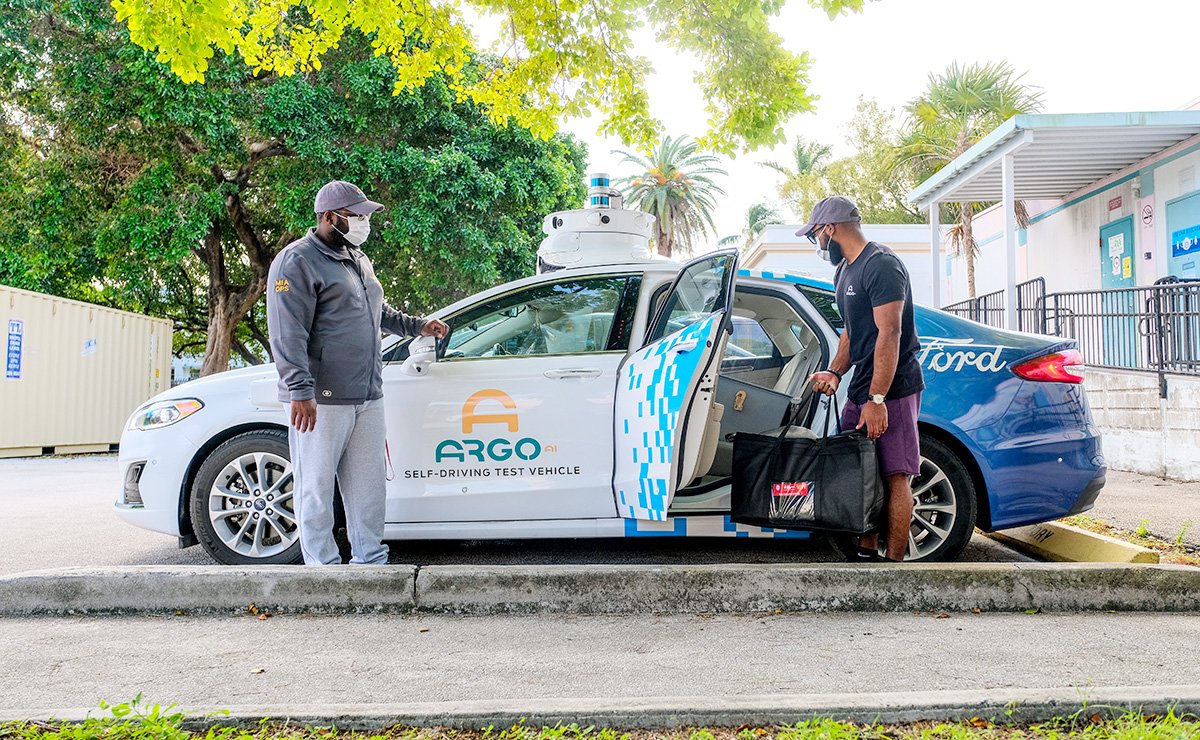| Miami nice: Ford and Argo use self-driving tech to keep fresh food on kids’ plates |

Before the pandemic struck, Miami-area nonprofit The Education Fund distributed fresh food to students at 26 schools, ensuring they and their families had enough to eat.
With some kids no longer attending school in person, organizers sought a safe way to keep them and their families stocked with healthy groceries.
Enter Ford Autonomous Vehicles and its self-driving technology partner, Argo AI. Miami happens to be where the two companies have been kicking the tires on their autonomous driving technology and, in parallel, developing the foundation of a commercial ride-hailing and delivery business.
The companies and The Education Fund embarked on a pilot project in late October that will conclude by the end of this month. The team is using self-driving test vehicles — with human safety drivers behind the wheel — to deliver food directly to 50 students who attend Miami Beach Feinberg-Fisher K-8 and Riverside Elementary Community School in Miami’s Little Havana area.
It’s a notable development because it’s the first time Ford has integrated Argo’s self-driving tech into customer-facing efforts. The service is helping to flesh out a fledgling business model.
“With real obligations to those expecting deliveries at a specific location and within a certain time frame, we’re refining our ability to coordinate our operations efficiently to meet our customer commitments,” Navin Kumar, director of AV business for Ford’s autonomous vehicles subsidiary, wrote in a blog post.
Ford isn’t the first company to use its self-driving test fleet to connect groceries and residents who need fresh food. This year, Nuro began using its fleet to connect the Houston Food Bank to a neighborhood where residents traditionally have trouble accessing fresh food. As the pandemic hit in April, Cruise started delivering from two food banks in San Francisco to residents who depended on them for meals.
Practically, these efforts have helped companies continue their self-driving testing throughout the pandemic when it otherwise may have been curtailed by local restrictions. But that’s not to discount the efforts.
Self-driving technology is often touted as a means for achieving societal progress, be it safer roads or improved accessibility to transportation. That’s not just about ensuring people can move around; it’s about ensuring goods can reach those who need them.
Even in test-only scenarios, these are some first examples of self-driving technology being used to boost the greater good.
— Pete Bigelow
What you need to know
Cruise starts driverless autonomous vehicle testing in San Francisco Cruise has joined the growing ranks of self-driving technology companies removing human safety drivers from at least part of their test fleets. But those safety operators won’t be going far — they’ll be in the passenger’s seat, company officials said Wednesday.
Aurora acquiring Uber’s Advanced Technology Group Aurora Innovation, the self-driving startup founded by three of the most prominent members of the fledgling industry, will soon add another big name to its ranks. The company said Monday it is acquiring Uber’s Advanced Technology Group, infusing the startup with workers and fresh funds. As part of the deal, Uber plans to invest $400 million in Aurora. In exchange for the cash and the self-driving tech, Uber will hold a 26 percent ownership interest in Aurora, according to Uber’s 8-K filing with the U.S. Securities and Exchange Commission. The deal is expected to close in the first quarter.
Advocates fear AVs will leave disabled riders behind For Carol Tyson, a proposal that would advance the commercialization of self-driving vehicles brought familiar pangs of frustration. Like so many others, Tyson, an advocate for people with disabilities, believes autonomous transportation holds the potential to unlock newfound independence and mobility for millions of Americans. However, blueprints for that future are missing vital components, namely vehicle designs and regulatory frameworks that address considerations for riders with disabilities.
Roundup
Zoox vehicle seen in San Francisco ahead of official reveal.
Uber asks states to prioritize its drivers for COVID-19 vaccine.
VW CEO expects autonomous cars on market by 2025-30.
Cadillac backtracks from Super Cruise ad claim.
Baidu becomes latest to join driverless ranks.
Apple shifts leadership of self-driving car division to AI chief, report says.
Mercedes-Benz is readying an eSprinter in two body sizes and with three battery options. It plans to bring the electric commercial van to the U.S. as early as the third quarter of 2023, according to people familiar with the matter.
New Toyota Mirai is meaner and greener, with an estimated range of 528 miles.
Automotive News and a panel of experts look at the direction transportation technology will take in light of the COVID-19 pandemic.
Michelin targets a more sustainable tire.
Toyota plans first electric utility vehicle for Europe.
Post-COVID, McLaren focus shifts to electrified future.
VW fixes software glitches in key ID3 electric hatchback.
GM plants’ EV conversion can be quick, straightforward, executive says.
Touchless pay a glimpse of Gentex future.
Brain food
AVs could extend independence for older adults.
Last mile
GM will launch a trailer-capable version of its Super Cruise technology on the 2022 GMC Sierra Denali.